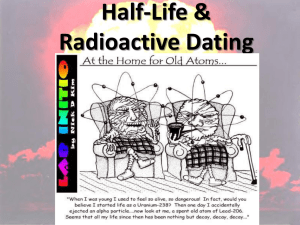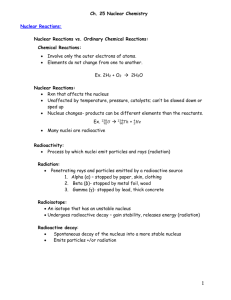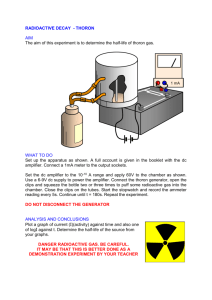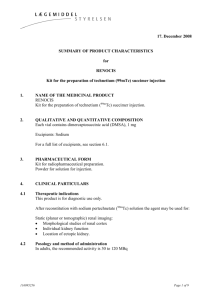Activity 3.3
advertisement
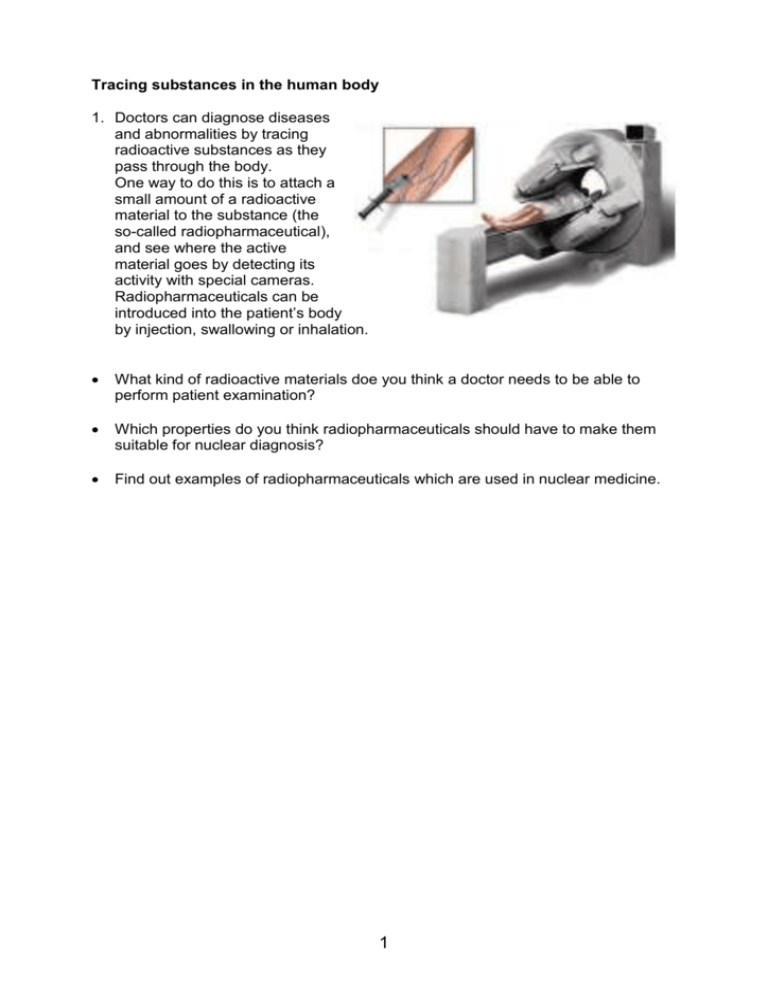
Tracing substances in the human body 1. Doctors can diagnose diseases and abnormalities by tracing radioactive substances as they pass through the body. One way to do this is to attach a small amount of a radioactive material to the substance (the so-called radiopharmaceutical), and see where the active material goes by detecting its activity with special cameras. Radiopharmaceuticals can be introduced into the patient’s body by injection, swallowing or inhalation. What kind of radioactive materials doe you think a doctor needs to be able to perform patient examination? Which properties do you think radiopharmaceuticals should have to make them suitable for nuclear diagnosis? Find out examples of radiopharmaceuticals which are used in nuclear medicine. 1 2. One of the widely used radioactive tracer isotope in nuclear medicine is Technetium-99m. What makes Technetium-99m so suitable for medical diagnosis? Read the article ‘Molybdenum and Technetium’. 2 Molybdenum en Technetium (source NRG in Petten, the Netherlands) http://www.nucleartechnology.nl/public/medical/valley/node6.html Technetium-99m is a radioactive material which is frequently used in every hospital equipped for nuclear medical examination. Technetium is called the workhorse of nuclear medicine. In 1995 in Europe 6 million diagnoses were made by means of technetium and a further growth in technetium demand is to be expected. Technetium is the favoured choice of the medical profession because it has the appropriate physical and chemical characteristics. The gamma radiation emitted has the appropriate energy to provide a good image whilst the radiation burden for the patient is very low. Technetium can easily be bonded to many different chemical materials and can therefore be used for a variety of diagnoses. Its half-life is 6 hours, long enough for a medical examination and short enough to allow the patient to leave the hospital directly afterwards. Technetium seems to have only one drawback: artificial radioisotopes must be produced in centralised facilities like such at Petten. So how can a material - half of which has disappeared after 6 hours - be delivered to each hospital every day? Here nature comes to our aid. Technetium-99 is the decay product from molybdenum-99 which has a half-life of 66 hours. This longer half-life allows transportation, even over long distances. The only remaining question is now: how to produce molybdenum-99. The shielded bottle contains molybdenum-99. The molybdenum (half-life 66 hours) decays into technetium99 (half-life 6 hours). This technetium can easily be chemically separated. In hospitals it is frequently used for diagnostic purposes. If a hospital receives a fresh bottle a so-called technetium 'cow' - every week, the doctors in the hospital can have technetium at their disposal any time of the day, seven days a week, by 'milking' the cow. Neither molybdenum-99 nor technetium-99m exist in nature. Molybdenum-99 can only be formed by means of nuclear reactions. It is formed during fission of uranium and consequently exists in 'used' fuel. Separation of molybdenum from used fuel is, chemically speaking, not very difficult. The only problem is the radiation level: fission products are highly radioactive. In the 'Molybdenum-wing' in the Petten Laboratory for Highly Radioactive Objects, two lines of five hotcells have been set up where molybdenum-99 is separated from irradiated uranium in five steps. The second line is basically a reserve line. Continuity must be guaranteed. It is of vital importance that sufficient molybdenum is available for distribution every week to the hospitals. With technetium-99m, the daughter of this molybdenum, 30,000 diagnoses are made daily in European hospitals. The fresh molybdenum-99 in this tube (a few micrograms) is sufficient for the diagnosis of some ten thousand patients. The highly radioactive molybdenum is divided over many hundreds of 'cows' which are shipped weekly to as many hospitals within and outside Europe. The molybdenum decays into technetium and with the technetium from one cow a large number of patients can be diagnosed. 3 For the selection of the most suitable radioactive tracer isotope the following criteria are taken into account: 1. The type of radiation emitted by the radioactive tracer isotope 2. The energy of radiation particles emitted by the tracer 3. The half-life of the tracer 4. Its binding to many chemical materials 5. Availability in the hospital 6. Possible radioactive waste Explain for each criterion why Technetium-99m is the ideal radioactive tracer for nuclear diagnosis. Molybdenum and Technetium does not exist in nature. The nuclear central NRG in Petten is the largest European producer of Technetium-99m. Explain in your won words how Technetium-99m is produced. 4 3. A doctor needs a radioactive material that decays quite quickly for two reasons. First, it needs to have enough activity to be detected. The second reason is to make sure the substance lasts in the body only as long as needed for investigation. Technetium-99m is widely used as a radioactive tracer that medical equipment can detect in the body. It is well suited to the role because during its decay to Technetium 99 it emits detectable 140 keV gamma rays (these are about the same wavelength emitted by conventional X-ray diagnostic equipment), and its half-life for gamma emission is 6.0058 hours (that means that 93.7% of it decays to 99Tc in 24 hours). The "short" half-life of the isotope (in terms of human-activity and metabolism) allows for scanning procedures, which collect data rapidly, but keep total patient radiation exposure low. A further advantage is that the gamma is a single energy, not accompanied by beta emission, and that permits more precise alignment of imaging detectors. The short half-life of Technetium-99m also creates a problem: obtaining Technetium99mwhen it is required. Hospitals cannot run their own nuclear reactors and so they rely on technetium generators - machines that produce Technetium-99m from the decay of its parent isotope Molybdenum-99. Molybdenum-99 has a much longer halflife and can therefore be transported to hospitals and remains useful for up to a week. Once Molybdenum-99 has been produced in a nuclear reactor it is placed into a technetium generator. The Molybdenum-99 starts decaying into Technetium-99m directly after its production. The technetium generator makes use of a technique called column chromatography and the fact that molybdenum likes to bond with aluminum oxide (alumina) while technetium does not. An example of such generator is shown in the drawing on the next page. 5 The molybdenum/alumina sample is placed in the center of the device, surrounded by a lead shielding. A sterilized saline solution is located in a container that is connected to the alumina capsule. The generator is “milked” by drawing a saline solution across an inner molybdenum/alumina capsule; during this elution process any technetium that has formed will be drawn away with the saline solution. When a doctor needs some technetium he sticks a vial with reduced pressure onto the needle that is connected to the saline solution via the alumina capsule. Saline solution flows to equalize the pressure, picking up technetium as it passes the alumina. The molybdenum gets left behind on the alumina. Preparation of an injectable technetium99m (Tc-99m) isotope tracer. This technetium source is held in clamp (is from an Amertec II generator supplied by Amersham International). Sterile saline is used to release the technetium from the generator's alumina columns. The radioactive solution is added to a tracer chemical before being injected into the body. Photographed at The London Hospital. 6 Conveniently, the optimum interval between technetium elutions is 24 hours. As the half-life of Mo-99 is 66 hours the generator itself can be used for approximately one week. It is then returned to the supplier and replaced with a new one. The technetium-99m is then used to label whatever pharmaceutical is going to be injected into the patient. The injection of the prepared pharmaceutical may be given immediately before the imaging process, or there may, for certain procedures, be a delay of several hours. The patient's details and the dose being administered are carefully checked by two people before the injection is given. A lead-screened syringe is used to protect the staff from unnecessary radiation dose. Origin: http://openlearn.open.ac.uk/mod/oucontent/ view.php?id=398664&section=6.2.1 The complete medical procedure is shown on the movie at: http://openlearn.open.ac.uk/mod/oucontent/view.php?id=398664&section=6.2 7 4. The radioactive part of pharmaceuticals that emits radiation is detected using a special camera called a gamma camera. The picture below explains how the gamma camera works. \ Origin: http://www.med.harvard.edu/JPNM/physics/didactics/basics.html The main components of a gamma camera are: Collimator is a thick lead plate with parallel holes in it. Its purpose is to let through only gamma photons which are going in a direction parallel to the holes. Detection crystal is a large crystal of sodium iodide. The crystal gives a tiny flash of visible light every time it is hit by a gamma photon. Photomultipliers convert the visible flash into an electrical signal. The electrical signals from the photomultipliers are analysed by a computer to construct an image. CT, ultrasound and MRI scanners transmit radiation to the patient. Does the gamma camera do the same? Describe in your own words how the gamma camera works? What is the purpose of the collimator? The procedure of gamma imaging of a lungs is shown on the movie at: http://openlearn.open.ac.uk/mod/oucontent/view.php?id=398664&section=6.4 8 5. It is possible to carry out gamma camera imaging by recording data from a large number of angles. These can be processed to produce tomographic images. An interesting application is a PET imaging (Positron Emission Tomography). Certain radioisotopes decay by positron emission and such radioisotopes can be used as tracers. A positron is a particle resembling an electron in all aspects except that it has opposite (positive) charge. In other words, a positron is antimatter: an antielectron. When a positron is emitted by a nucleus, it almost instantly finds an electron and the pair annihilates, converting all the mass energy of the two particles into two gamma rays, which travel exactly in opposite direction. A simultaneous detection of gamma ray photons in two detectors places the source on a line between those detectors. Detection at several angles permits precise location of any concentration of the radioisotope. An image of a slice of the body (called a tomograph) can be constructed by using a ring of detectors. PET scans are increasingly used for all parts of the body, but have been of particular value for imaging of the brain. A positron emitter that can be inserted into a glucose molecule is the fluorine isotope 18F. The glucose passes the blood-brain barrier and enters the brain easily. The concentration of the radioactively tagged glucose is a measure of the level of metabolic activity at that location in the brain. PET scan of a brain, the white arrow points a brain tumour. 9





